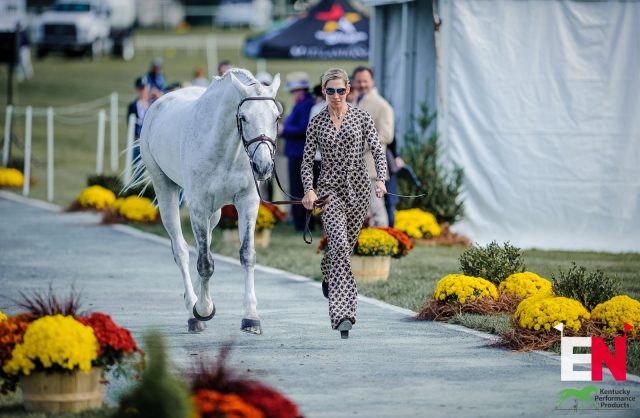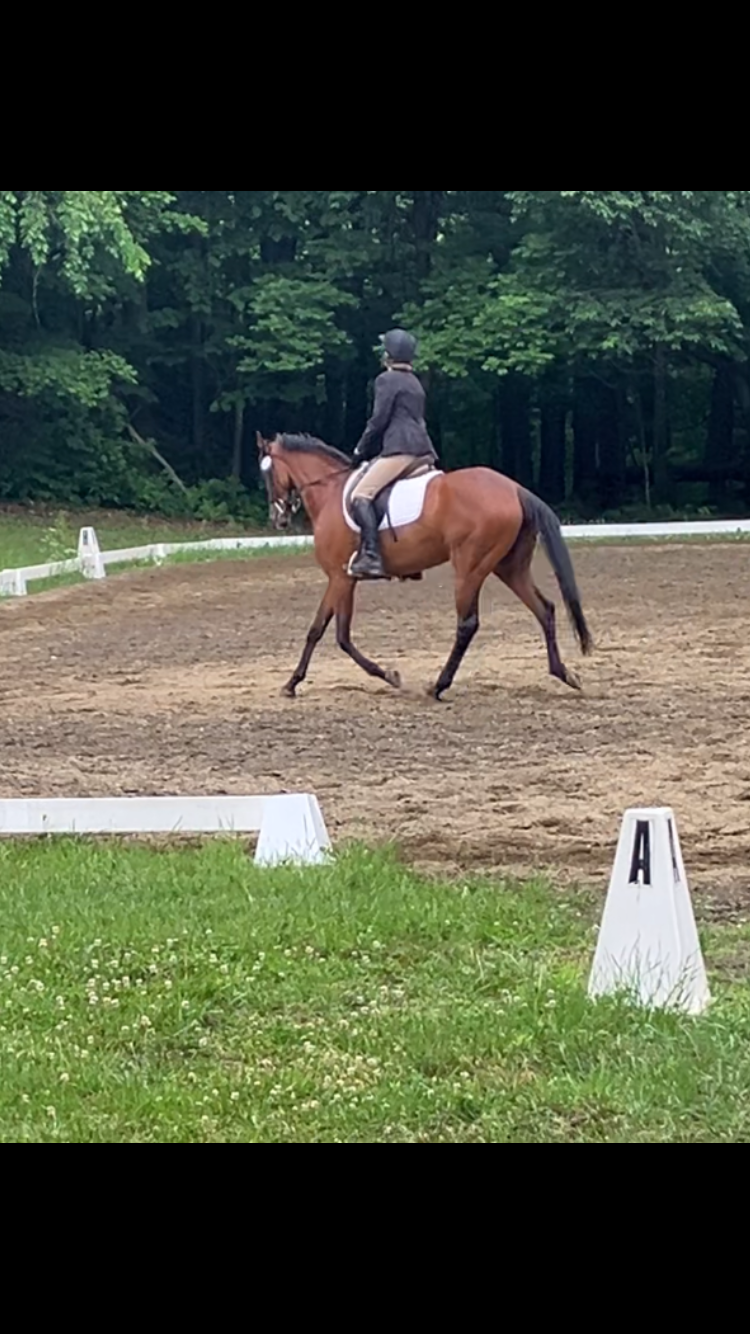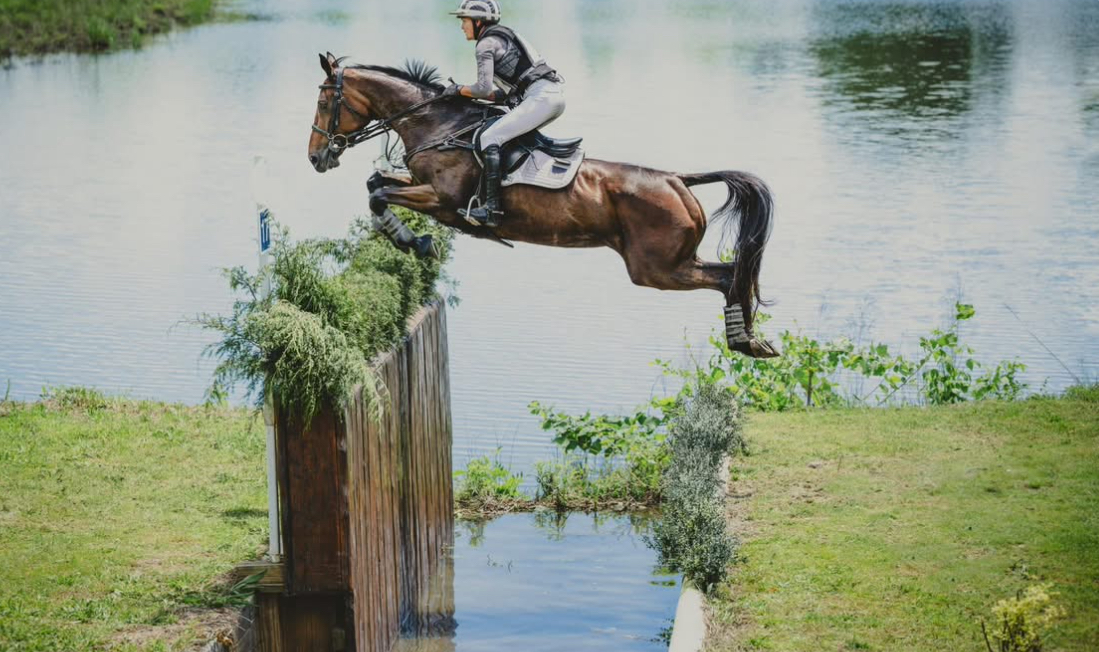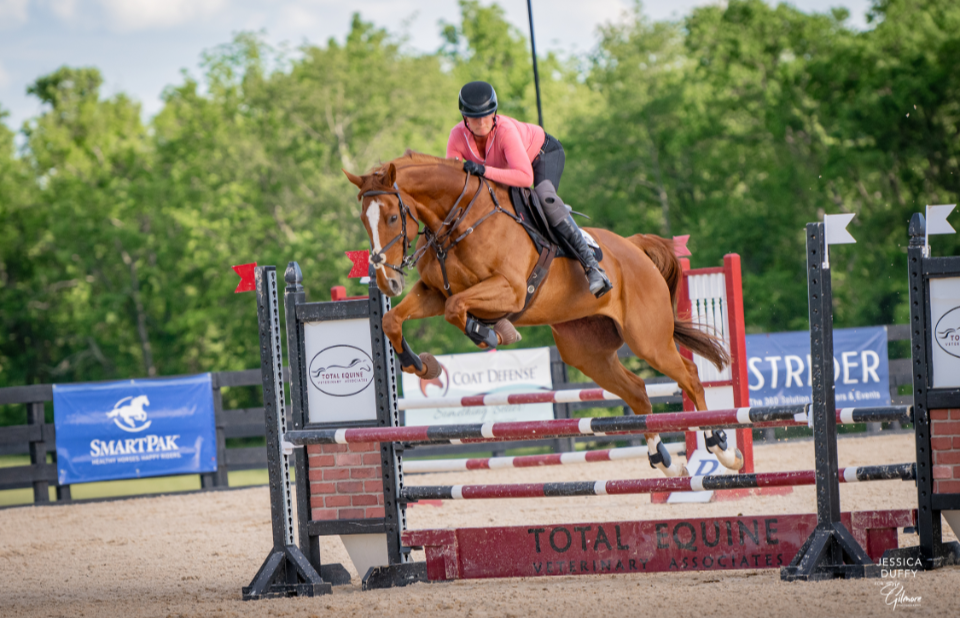As is tradition here on EN, we love to nerd out ahead of a major competition and make our picks. For the MARS Maryland 5 Star, presented by Brown Advisory, it’s a small-but-mighty CCI5* field to choose from, and we’ve broken out our picks into a few different categories this week. Check out the full entry list here (and, if you want more detail on each pair, click here to view EN’s Form Guide inside this year’s program) and keep reading to see EN’s picks + submit your own for a shot at winning some cool prizes.
Up for grabs is a prize bundle containing:
One primary U.S.-based winner will be drawn from correct picks to receive the grand prize. Additionally, one international-based winner will also be drawn to receive a bundle of EN Merch! Prizes will be drawn the week of October 17 and the winners will be announced in News & Notes and notified via email. Scroll down to submit your entry ahead of the start of dressage (the form will close at 1:30 p.m. EST tomorrow, October 13).

Oliver Townend and As Is. Photo by Hannah Cole Photography.
SHELBY ALLEN
First Phase Dominator: I would keep the flaming hot cheeto Danito on your radar. Though it’s his debut at the level, he’s proven himself a fierce competitor on the flat. Recent notable dressage marks include a 24.7 at Boekelo last autumn and a 23.9 at Jersey Fresh in 2021.
XC Machine: Phillip Dutton has been around a few five-stars in his career, and he’s on Z, a horse who hasn’t had a cross country penalty in the last three seasons (and before that only from a flag penalty or fall of rider). That, combined with the bittersweet motivation of being a World Championship traveling reserve, will make them a force to keep your eyes on Saturday.
Show Jumping Star: Dondante has a penchant for the final phase, having only one or two poles down at International events in his entire career. The final phase could prove lucrative for him and Will Coleman.
Sleeper Alert: It seems hardly fair to call Liz Halliday-Sharp a “sleeper” but she’s my choice for a U.S. victor. Partnered with Cooley Quicksilver, it could definitely be in the cards. “Monster” had strong performances at both the Luhmühlen and Pau 5*s, but those tracks are much different to this weekend’s. That considered, the horse’s record gives me confidence that he and Liz could go for it — he can be quick on cross country and come Sunday the poles will more than likely stay up.
Maryland 5 Star Winner: Oliver Townend is usually a pretty good bet a at a 5*, but this will be a debut for As Is, though the Andrew Nicholson-produced ride is not short for experience. Though he may be just above the mark on the flat, he’ll finish on that result. Oliver knows how to get the most out of horses on cross country, and the striking grey has never had a pole down at an International, giving him a good shot at the win.

Tim Price and Coup de Coeur Dudevin. Photo by Tilly Berendt.
TILLY BERENDT
First Phase Dominator: I loved watching Tamie Smith and Danito at Boekelo last year, where they ultimately finished tenth — but it was their first phase that really got people talking. The tiny orange dynamo put a 24.7 on the board on that occasion, and he’s been similarly well-marked in other CCI4*-L competitions, including earning a 23.9 at the Jersey Horse Park last year. Tamie is a real perfectionist in this phase and doesn’t throw a mark away, so I think we’ll see them set the standard for the rest of the field.
XC Machine: He’s a five-star debutant, but Oliver Townend‘s As Is is a really interesting horse in this line-up. He’s Spanish-bred, from the same farm as former rider Andrew Nicholson’s stars Nereo and Armada, and he’s been seriously consistent, and seriously fast, since stepping up to four-star. We’ve not seen him finish outside the top ten in an international since 2019, and while Oliver’s only been competing him this year, he’s already nabbed a placing in the toughest four-star in the world, Bramham CCI4*-L. He should go the distance here without much trouble.
Show Jumping Star: I wouldn’t historically have put Liz Halliday-Sharp‘s Cooley Quicksilver in this spot, but whatever she’s been doing with him this season is working — he’s become a really reliable final-phase horse, and has just had one rail at the very start of the season in internationals. He made Luhmühlen’s showjumping course — the toughest in the world at this level — look like a real doddle back in June. It’s a tough call whether I want to put this pair as my jumping stars or my winners, if I’m honest. Liz is riding a high after a super week at Boekelo with Mik’s Master C, and she’s got the highest win chance according to our pals at EquiRatings. Cooley Quicksilver might have been an overcooked noodle of a horse in his scrappy youth, but he’s turned into a serious competitor, and his performance at the Germany five-star this summer certainly looked like the precursor to a major win. I think this could well be his to walk away with.
Sleeper Alert: Can we call anything Tim Price rides a sleeper, really? But of all his horses, new ride Coup de Coeur Dudevin is the biggest unknown: he’s been very exciting at the lower international levels with former rider Chris Burton, but he only joined Tim’s string at the start of this year and has done just three long-formats in his career. I loved watching him in the very, very competitive and tough CCIO4*-S at Haras du Pin in August, though, and certainly saw in him the sparkle of something special. For Tim to bring him all the way to the States as the one Price family entry this year tell me that he feels exactly the same way. I think this is the week we all learn this cool ten-year-old’s name.
Maryland 5 Star Winner: I’ve long loved Astier Nicolas’s sweet Babylon de Gamma, whose path to greatness has deviated a few times from its intended route as the result of niggling injuries and a hoof situation that bubbled up after his tenth place finish here last year. Time and patience are great healers, though, and although we were robbed of the chance to see the striking gelding at Tokyo or Pratoni, he’s got something very big in him. He comes here off the back of a decisive win in the intense CCI4*-S at Scotland’s mountainous Blair Castle, and I think that’ll prove to be the perfect prep for this week’s course.

Astier Nicolas and Babylon de Gamma. Photo by Tilly Berendt.
AMANDA CHANCE
First phase dominator: Tamie Smith & Danito
This is a horse that was bred for dressage, ridden by someone who is exceptional in the first phase… hard to bet against them!
XC Machine: Quantum Leap
This Maryland-bred gelding has been really fun to watch come up the levels. He’s got the scope of his warmblood sire and the gallop, heart, and speed of his thoroughbred dam. At last year’s Maryland 5 Star, Quantum was clear with 1.2 time, and at Kentucky this spring he was again clear with 1.2 time. Doug is a fast rider and I bet he’s itching for that elusive double clear – this horse is certainly capable of delivering.
Show Jumping Star: DonDante
This one was a struggle for me between As Is and Don Dante. Both have excellent records over the colored sticks but Don Dante comes from the Diamant de Semilly sire line, showjumping royalty, so… ultimately that’s what pushed me to give him the nod.
Sleeper Alert: Coup de Coeur Dudevin
Ok I’m willing to admit that I’m not sure any horse ridden by a Price could ever truly qualify as a sleeper, BUT it’s the horse’s 5 star debut and his first time leaving the continent – that makes him a bit of an unknown quantity here. That said, he is being piloted by the world #1 and he’s yet to add a cross country jump penalty to his FEI record. Plus his dam is by 5 Star horse Leprince des Bois, and we’ve got a Leprince des Bois filly here on the farm, so there is an immediate bias that I won’t apologize for.
Overall Winner: Babylon de Gamma
I know, I know, I bet all my imaginary money on the French for Pratoni and ended up cursing them all, so apologies in advance to Astier but I just love this horse. He pings off the ground like he’s got springs in his feet – maybe not surprising since he’s by an Olympic showjumper and out of a French Anglo Arab mare. Such a très chic and very typically French pedigree, lots of blood and lots of scope. This horse did well here last year, adding just a handful of time to his dressage score, and they’ve shown improvement since that performance.

Woods Baughman and C’est La Vie 135. Photo by Shannon Brinkman Photography.
EMA KLUGMAN
First Phase Dominator: C’est La Vie 135 (Woods Baughman) strikes me as the one to watch to lead the dressage. This striking horse is really impressive in this phase, and if he can follow it up with good cross country and show jumping performances, he could be one to watch to snatch a top placing.
XC Machine: FE Lifestyle (Jennie Brannigan) is an amazing cross country horse and if the track is especially difficult, this will be his day to shine. The course designer couldn’t build a fence too big for this horse to jump, and it will be a treat to watch the well-seasoned go around.
Show Jumping Star: DonDante (Will Coleman) is really strong in the show jumping. He rarely has a rub, much less a rail, and his jockey is also very stylish in this phase. I think that if he entered the final day in a strong position, he could move up the placings onto the podium if the show jumping track is difficult.
Sleeper Alert: Superstition (Harry Meade) has now done a couple of American five-stars, and he always turns in a very solid performance. If he can knock off a couple of points in the dressage, he is capable of finishing on that score and quietly rising up the standings.
Maryland 5 Star Winner: You absolutely cannot bet against Tim Price at the moment. He could be on a mustang and still have a shot. Jokes aside, the riders coming from overseas would not enter if they didn’t think they had a shot at the prize money. Even though Tim is on a 10 year-old five-star first-timer, Coup de Coeur Dudevin, he could well win the whole thing.

Doug Payne and Quantum Leap. Photo by Abby Powell.
ABBY POWELL
First Phase Dominator: No stranger to leading the field after the first phase (or any of the phases, mind you) I’m betting that we’ll see the familiar names of Liz Halliday-Sharp and Deniro Z at the top of the leaderboard when the dancing is done and dusted.
XC Machine: Zoe Crawford‘s K.E.C. Zara is the definition of an XC Machine to me. They won’t be contesting the top of the leaderboard after the dressage and they may not be in the ribbons at the end of the weekend either, but they’re sure in contention for the biggest mover award thanks to this mare’s zest for cross country!
Show Jumping Star: I have to admit to not keeping up with show jumping statistics very well, but Quantum Leap, really jumps out at me (but not intended, but welcomed) as being exceptionally strong in this phase. This horse clinched the CCI5* National Championships thanks to a double clear round in his debut at the level in Kentucky this spring and you know he and Doug Payne put in plenty of practice over the poles.
Sleeper Alert: I have to admit, I don’t know very much about As Is, the former Andrew Nicholson ride who is now ridden by Oliver Townend. But I do know that Oliver wouldn’t be flying him across the pond if he didn’t believe he were a right contender for the top.
Maryland 5 Star Winner: I may have picked Deniro Z to lead after the first phase, but I’m going to get top honors to his stable mate, Cooley Quicksilver, who (from a rudimentay glance at FEI records) looks to be just a bit faster across country and is seriously on top form with Liz Halliday-Sharp this year. Here’s to another home-country five-star winner!

Liz Halliday-Sharp and Cooley Quicksilver. Photo by Erin Gilmore Photography.
SALLY SPICKARD
First Phase Dominator: Danito
Ever seen a Cheeto Puff dance? Well on Thursday afternoon we’re likely to see just that. The early dressage lead is likely to be taken by Danito and Tamie Smith, who can coax a 25 out of a giraffe if she needs to, and while this test is a step up for the 13-year-old Hanoverian gelding he’s already shown his prowess for the first phase at the 4* level. If he can put the pieces together, Danito’s also game to finish on that score, but Tamie may choose to prioritize education over competition come Saturday.
XC Machine: Superstition
At this level, it’s often hard to find a horse without a cross country penalty on its FEI record, but the 13-year-old Superstition, ridden by Great Britain’s Harry Meade, has managed to achieve this in 23 international competitions. Truth be told, this pair could easily make me eat my words when it comes to my winner pick — they knocked on the door at both Kentucky and Maryland in 2021, finishing 5th and 7th respectively. Cross country is this horse’s jam, and Harry won’t be hanging about on Saturday as he tries to catch that elusive podium finish.
Show Jumping Star: Quantum Leap
Gotta go with the part-time show jumping rider on this one (though you could easily slot Quantum Leap into the Sleeper or even potentially the Winner spot here). Quantum Leap is piloted by the very experienced Doug Payne, who knows a thing or two about turning and burning. Show jumping here at Maryland can feel a bit like a fishbowl with the close arena sides and small dimensions in comparison with its Kentucky counterpart, so the ability to come forward, not succumb to distraction, and turn efficiently will all play a key on Ken Krome’s show jumping track later this week.
Sleeper Alert: Twilightslastgleam
I’ve been a huge fan of this big-galloping Thoroughbred ever since I caught a glimpse of said gallop during Young Event Horse finals at this venue several years ago. Add in the fact that he’s got a big 4*-L win under his belt with “Need for Speed” Jennie Brannigan at Bromont this summer and the fact that Ian Stark builds — you guessed it — big, galloping tracks and I think you could well see this pair slip right up into the top five or even onto the podium when the dust settles Sunday.
Maryland 5 Star Winner: Cooley Quicksilver
It feels odd to go against the reigning world #1 (Tim Price) and former world #1 (Oliver Townend), but I am going to give this nod and a first 5* win to Liz Halliday-Sharp and Cooley Quicksilver. This pair won the very tough Lexington 4*-S this spring and followed that up with a top-5 finish at Luhmühlen. Despite his relative young age, “Monster” is well-traveled and has all the chops to put in a personal best weekend: he’s solid on the flat, he’s nippy and bold on cross country, and he can leave the poles up on Sunday. Liz, a need for speed lady herself, is oh-so-competitive, so you know she’ll be gunning for a top finish this weekend with plenty of momentum on her side coming off a strong finish at Boekelo last week aboard Miks Master C.
Now, it’s your turn! Up for grabs this week is a $100 Starbucks gift card provided by Ocala Horse Properties, a 6-pack of FLAIR Equine Nasal Strips in the color of your choice from Achieve Equine, and an EN merchandise bundle. Submit your pick to win as well as the winning score for tie-breaking purposes no later than Thursday (10/13) at 1:30 p.m. EST to be eligible to win! Use the form embedded below or click here to submit.





























































































